Dear creative friends,
Welcome to the Studioworks Journal's Issue No. 83. Every creative life calls for us to examine ourselves and get to know the person who creates the art. to comprehend how our inner rhythm, personality, and emotions influence not just what we create, but also why.
We are invited into that silent investigation by our theme, Know Thyself: The Artist Within. It involves observing our creative tendencies, patterns, and the subliminal forces that direct our expression.
Artists have demonstrated throughout history that the act of creating art can serve as a mirror for the soul, allowing us to see ourselves more clearly.
Creativity becomes less of a struggle and more of a dialogue when we learn to work with, rather than against, our own nature.
Allow your art to speak for itself. Allow it to reveal the reality that lies behind your hands.
xo,

Art has forever been the result of an interplay between personal creative expression, cultural influence, and the mercurial effects of time. Artists navigate this dialogue between self and society in ways that alternately align with or resist the values of their age—but always reveal a vital exchange between the individual and the world around them.
As artists, we have much to gain from observing those who came before us, for example, through examining the emergence of formalized efforts to “Know Thyself” and reflecting on how this collective social theme has shaped art across time. By learning from the steps taken by other artists as they engage in self-reflection, we can better forge our own creative path forward. Join me in exploring the impacts of emergent ideas in psychology, introspection, and the search for identity from the Renaissance to the present, and discover how we can draw inspiration by turning the mirror inward.
In an era where self-help and selfies are ubiquitous, it seems difficult to imagine a time when the idea of self-reflection, on both deep and superficial levels, was uncommon. Though the phrase “Know Thyself” is attributed to the ancient Greeks, with its inscription on the walls of one of Apollo’s temples at Delphi, the process of attempting this feat seems to have been more the domain of philosophers than of everyday people. Renaissance painters had a role in changing all that, as did the Symbolists, and the emergence of Modern Psychology.
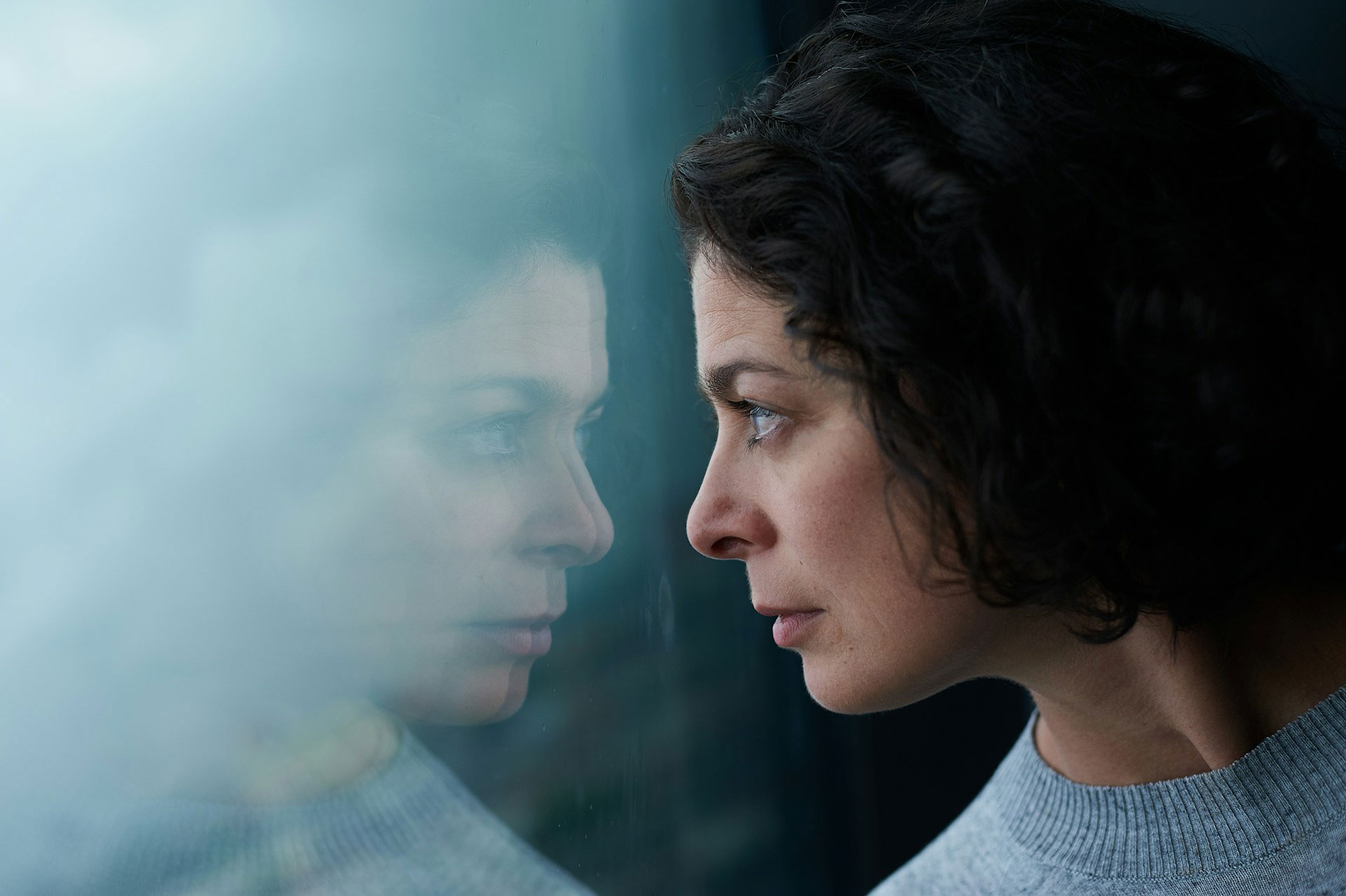
A cornerstone of this period of history was the creative re-imaging of concepts that held longstanding value for human society. The question, “Who am I?” is as old as time. Part of the rebirth inherent in the Renaissance was the establishment of self-portraits as a legitimate and worthwhile subject of the artist class, which addresses that big question. This process enabled painters to engage in self-expression and project an image of who they thought they were and how they wanted to be seen, often in the attempt to elevate their status from craftspeople to artists endowed with a creative gift from god.
Some scholars cite the 1433 painting Portrait of a Man by Jan Van Eyck as the earliest known self-portrait. Whether or not this is the case, the existence of the self-portrait as an established sujet de arte appears to begin in the early 1400s. Interestingly, the practice also coincided with the emergence of broader availability of high-quality mirrors, which is a logical correlation. How can you paint yourself if you never get a clear impression of how you appear?
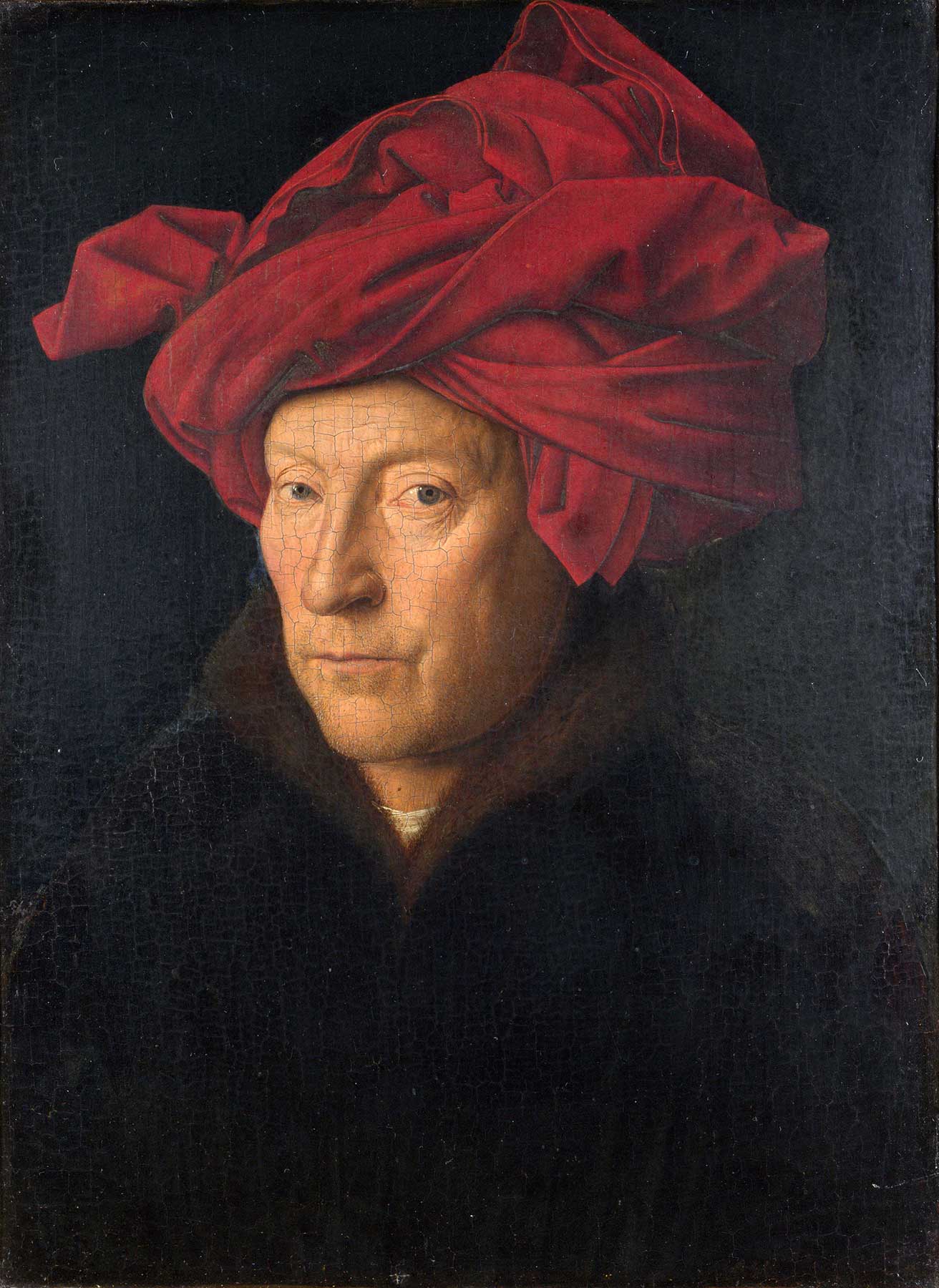
Portrait of a Man
By Jan Van Eyck, 1433
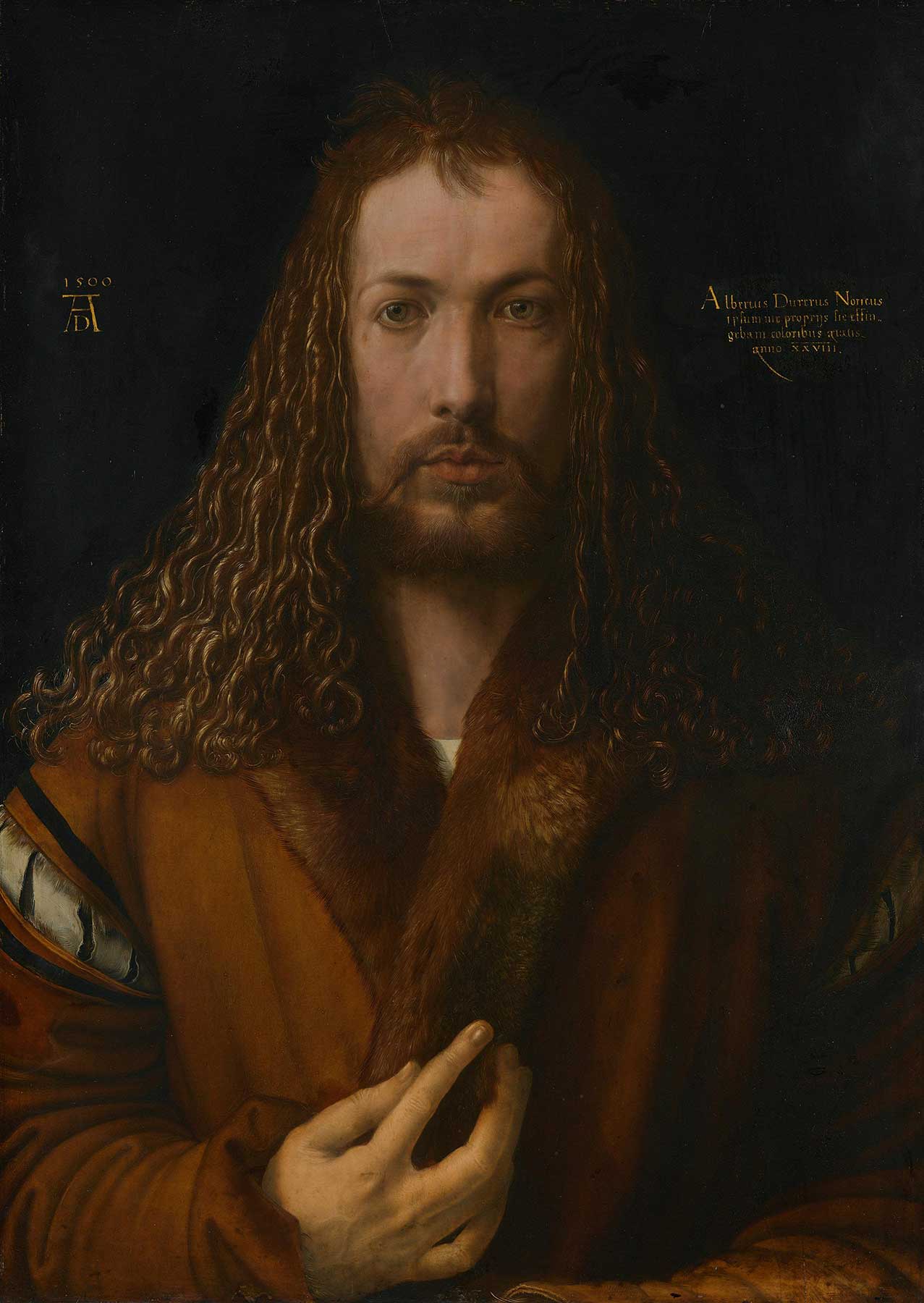
Self-Portrait at 28
By Albrecht Dürer, 1500
Perhaps most famous among Renaissance self renderings is Albrecht Dürer's Self-Portrait at 28. What makes this painting so remarkable, beyond its beauty and demonstration of skill, is the deliberateness with which the young man depicted himself in a Christlike fashion, wearing a fur collar-a status symbol of the day- and gazing through the viewer into infinity. Although neither rich nor part of the elite class at the time of the painting, Dürer's efforts to immortalize himself and demonstrate his special gifts laid the groundwork for the establishment of the notion of the “Renaissance Man” or a pure artist with a superstar aura. This desire is a fundamentally human one, i.e., the urge to present ourselves as something unique, valuable, and imbued with greater significance.

Medicine
By Gustav Klimt, 1907
Symbolism found its roots in the late 19th-century efforts of artists to slough off the constraints of the artistic dogma of the time. In an attempt to distance themselves from Realism and Naturalism, painters of this era embraced classical allegory as a means to express not only universal but also deeply held personal emotions through the development of a highly individualized symbolic language. This process deepened the efforts of earlier artists to portray themselves in a particular light by placing greater emphasis on the inner experience of the creator and their desire to connect with their viewers on a felt level.
Several artists successfully managed to emancipate themselves from literal depictions, conveying complex and profound internal states in a way that emotionally moved others. A prime example of this is Edvard Munch's The Scream. This piece conveys intense anxiety and inner turmoil, lending itself as an enduring symbol of existential angst.
Another piece that skillfully incorporates potent allegorical images is Gustav Klimt’s Medicine. This piece evokes thoughts about the major themes of life, including birth, death, and the struggles of the human condition, which entail frailty, fear, and questions of personal meaning. Though the painting was tragically destroyed in 1945, the surviving sketches and descriptions serve as an exemplary model of the artist who tackles what challenges themselves most and beautifully depicts the results in a way that is universally moving.
Taking self-examination a step further was the birth of Modern Psychology. Its origins can be traced to the establishment of the first laboratory for experimental psychology by Wilhelm Wundt in Leipzig, Germany, in 1879. This created an empirical basis for the study of the mind, separating psychology from philosophy and giving it credibility as a science. William James’s seminal work, The Principles of Psychology, published 11 years later, established a discipline that paved the way for pioneers like Freud and Jung to articulate essential concepts, including the unconscious, defense mechanisms, archetypes, personality types, and individuation.
From an artistic perspective, these advances in understanding the fundamentals of the human mind and experience have yielded a treasure trove of creative inspiration. A brilliant example of an artistic depiction of unconscious elements and shadow is Oscar Wilde’s gothic horror novel, A Picture of Dorian Gray.
Written in the context of a repressive Victorian society, Wilde taps into the cultural push to sublimate the unconscious and emphasize an external image of purity and beauty. The principal character, Dorian Gray, fails to integrate the conscious and unconscious aspects of his personality, with disastrous consequences. The story powerfully illustrates the dangers of refusing to confront brutal truths, projecting internal conflicts onto the world, and allowing a schism to form between what lies within and what we show to the world. Furthermore, it provides an exemplary creative expression of the unexamined self.
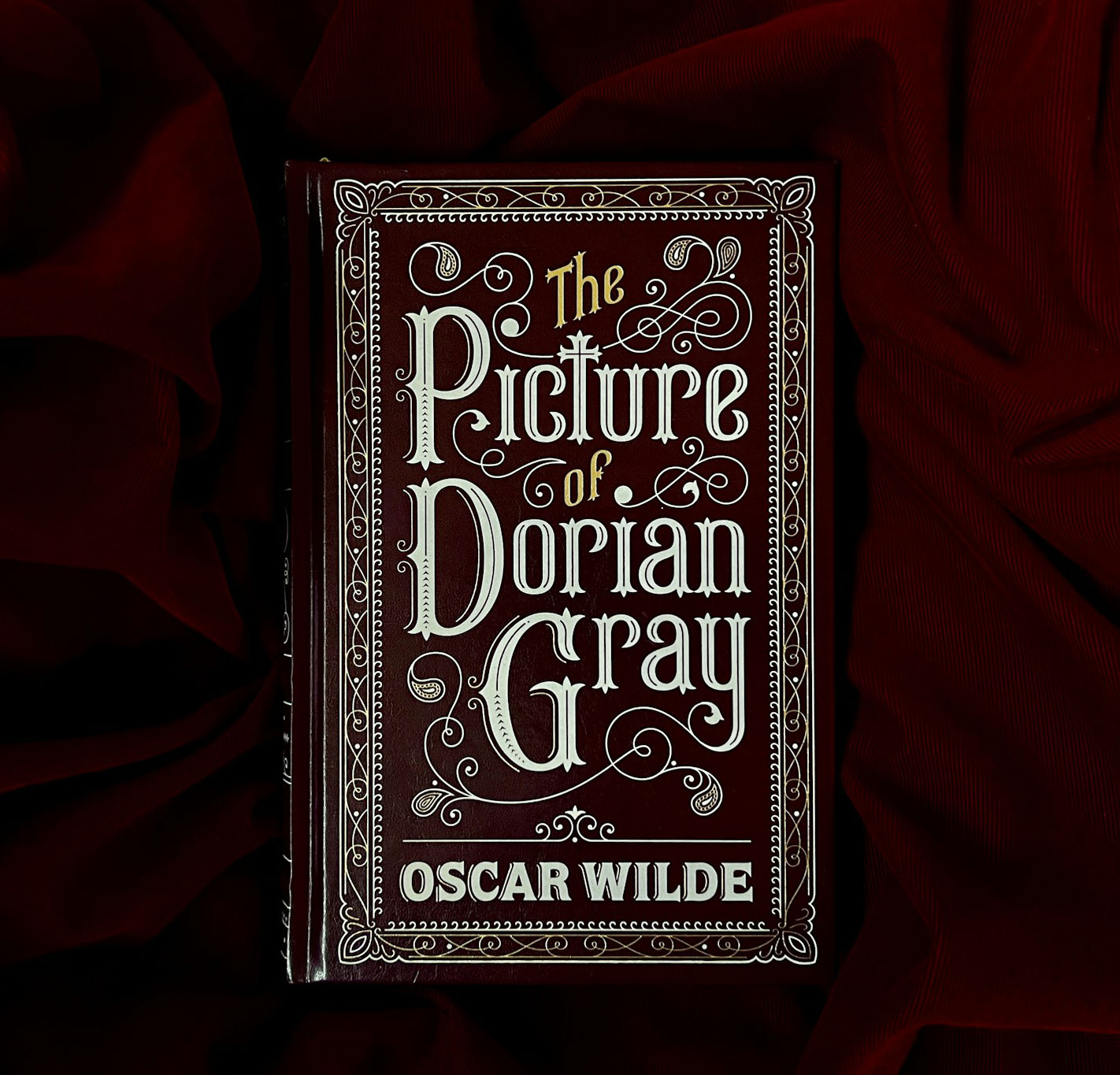
Over time, artists have used many formats to engage in self-discovery. They range from a strong emphasis on surface features and how we perceive ourselves, as well as our hopes for being seen, to using elaborate symbolism to evoke an understanding of more profound feelings, to wholehearted self-analysis. Additionally, they each show how a process of introspection can unlock a limitless font of inspiration.
As creatives, we can conjure that energy every time we choose to pick up the mirror, literally and figuratively. We can explore the surface, tracing every feature. We can dive deeper and mine the archetypal world of symbols to convey more than words. Ultimately, we can begin to fully befriend our ever-evolving and sometimes contradictory inner dimensions and tap into the fantastical possibilities that lie within the reflective self.

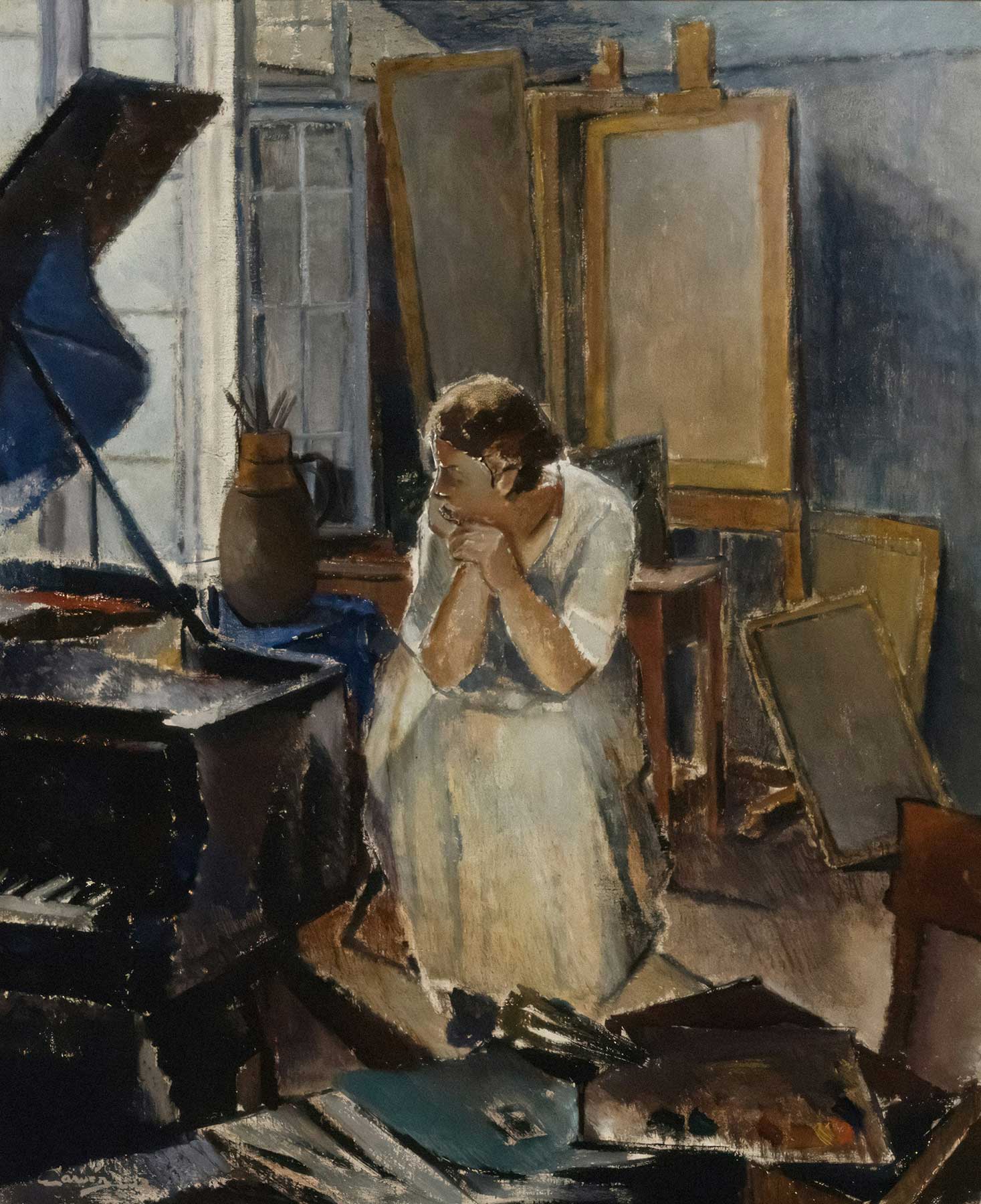
Studio Interior
By Cawén Alvar, 1559
At the heart of every creative practice is the person who shows up to make the work. Behind every brushstroke or sketchbook page lies a whole landscape of habits, emotions, and desires, the quiet forces that shape how and why we create.
Understanding those inner patterns can transform our art. It helps us recognize when we’re in flow, when we’re forcing, and how our personality influences our relationship to the creative process itself.
One tool that can bring surprising insight into this inner landscape is the Enneagram, a psychological and spiritual framework that maps nine distinct personality types. Each type describes a core motivation, what drives us, what we fear, and how we seek connection and meaning.
Unlike other systems that focus on traits, the Enneagram explores patterns of attention. It’s not meant to define you, but to help you recognize the habits and assumptions you’ve learned to live by and to see the freedom that exists beyond them.

While it feels modern, the Enneagram has roots that stretch back centuries. The nine-pointed symbol itself has appeared in mystical and philosophical traditions from ancient Greece to Sufi teachings, representing universal patterns of balance and transformation.
In the early 20th century, George Gurdjieff, a spiritual teacher of Armenian and Greek descent, introduced the Enneagram figure to the West as a model of consciousness and self-observation. Later, Chilean philosopher Oscar Ichazo and psychiatrist Claudio Naranjo refined it into the nine personality types we know today, combining ancient wisdom with modern psychology.
What began as a spiritual tool for inner awareness evolved into a practical map for understanding human behavior. At its heart, though, the Enneagram remains a guide for self-knowledge and transformation, helping us see not just what we do, but why we do it.
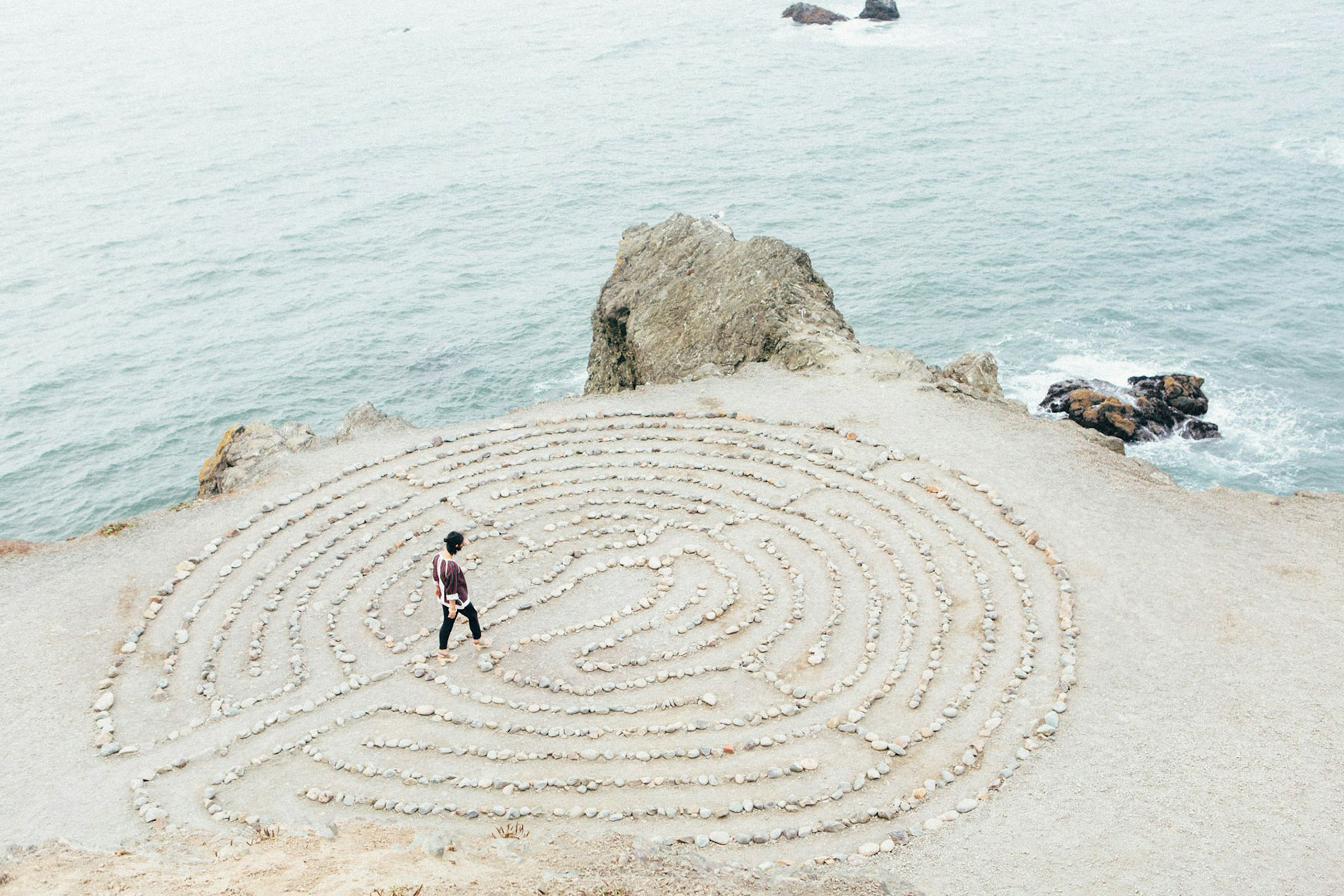
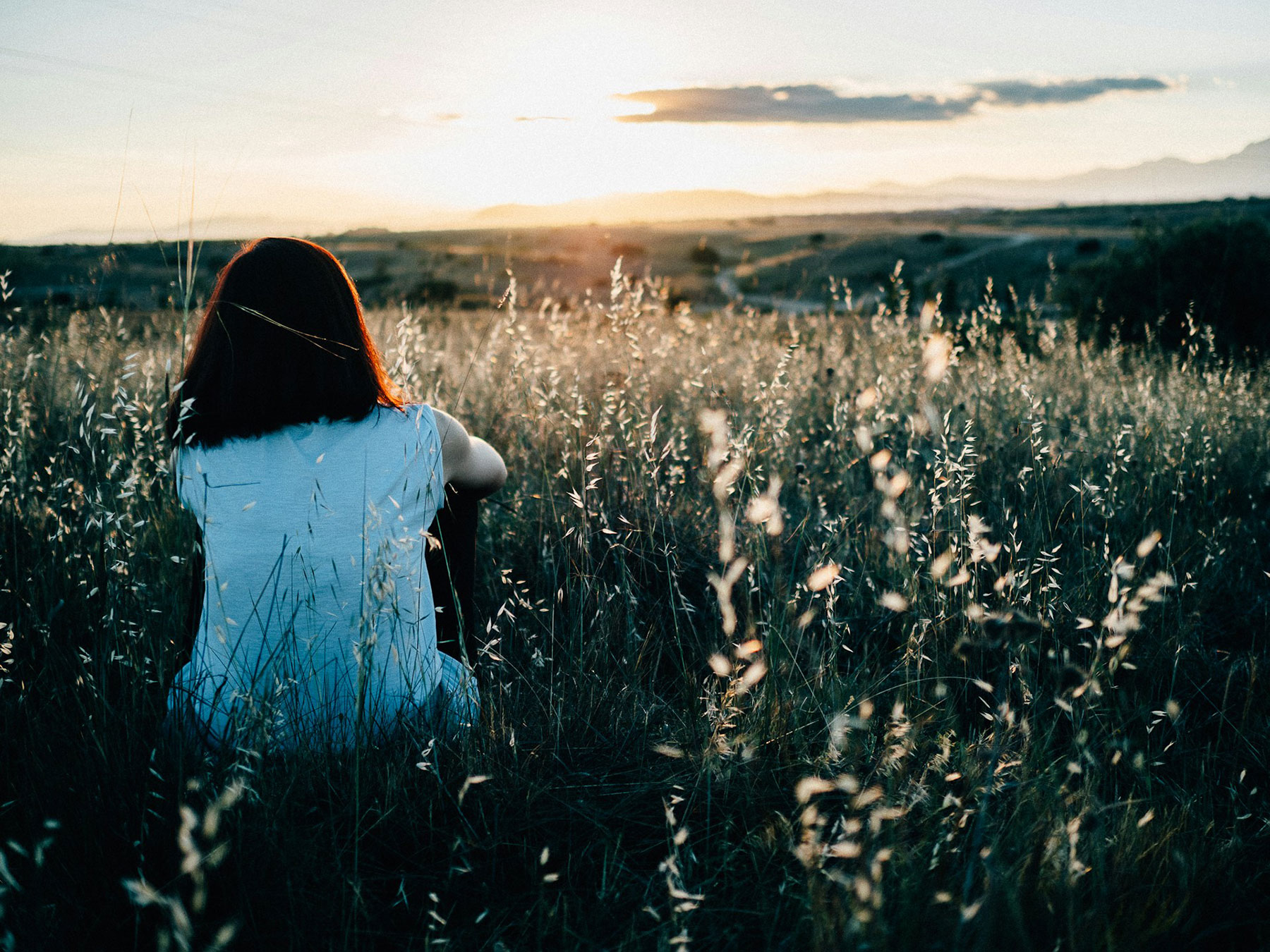
The Enneagram invites us to see how our inner stories shape the way we create. A Type One might over-edit, chasing perfection. A Type Four might romanticize melancholy. A Type Seven might chase novelty without finishing. Seeing these patterns with compassion, not criticism, gives us freedom to choose differently.
Self-knowledge helps us balance our creative energy. It teaches us when to rest, when to risk, and how to make art that feels aligned, not forced. The more we understand our temperament, the easier it becomes to nurture a practice that truly fits who we are.
(this one takes about 10 mins but gives you immediate results)
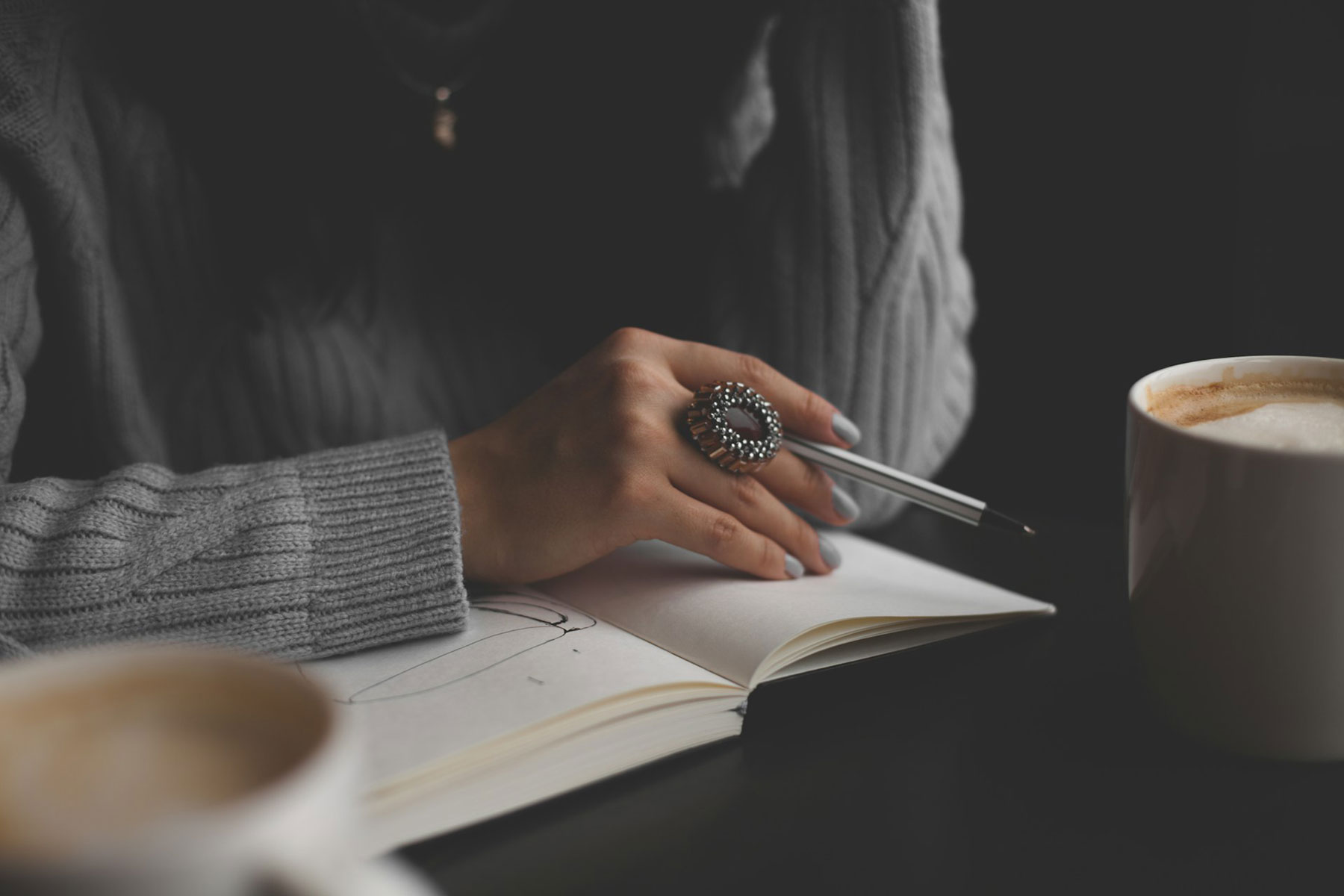
What struck you as immediately true about your Enneagram type? What caused you to hesitate or object?
How do your personality traits influence how you approach inspiration, time, and art?
What kind of artistic expression does your type yearn for? What does it typically conceal or withhold?
What trait from the growth path of your type could you cultivate to make your creative life easier or more genuine?
How can knowing your type help you meet yourself more compassionately and trustingly, as well as your art?
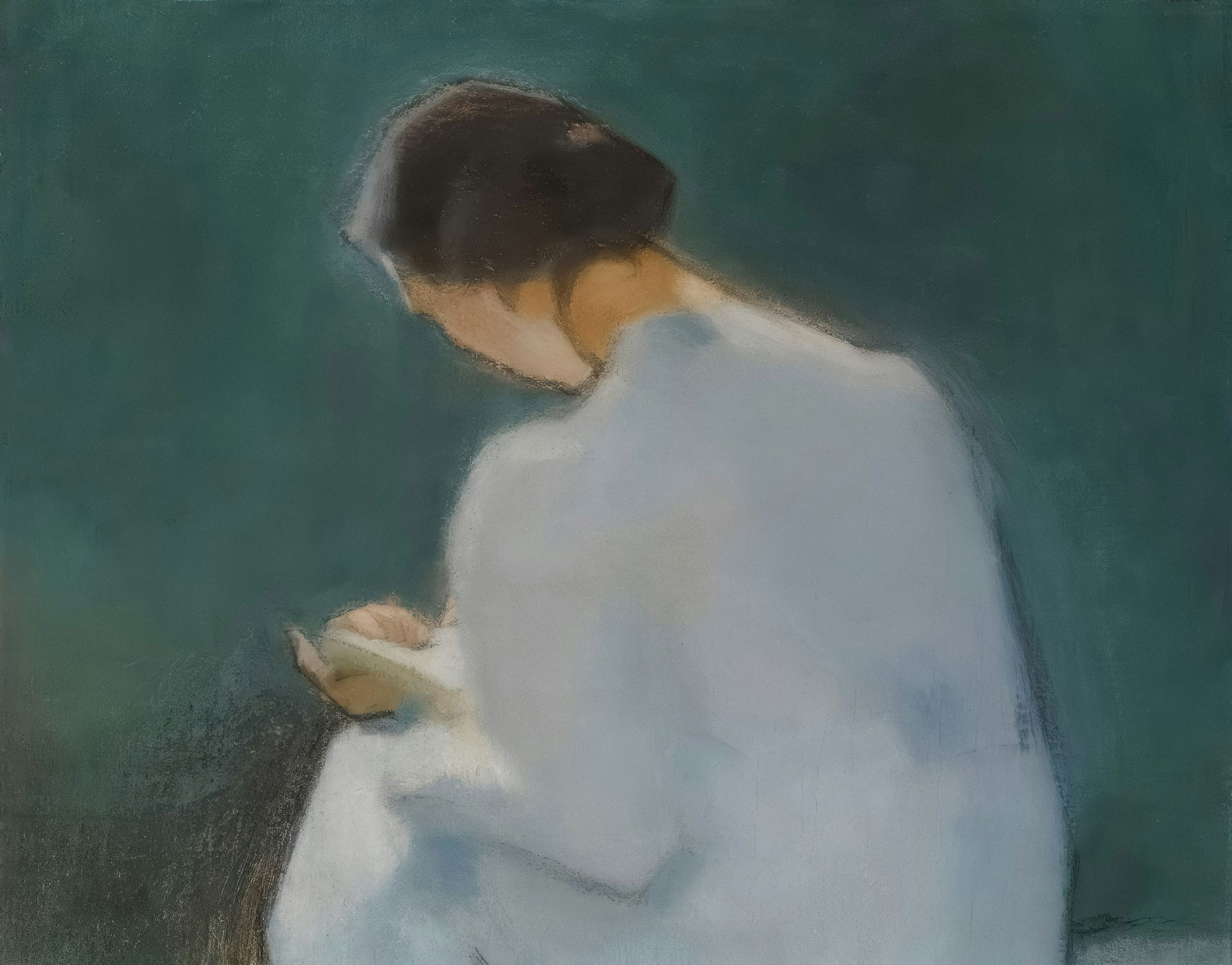
Maria
By Helene Schjerfbeck, 1909
I was dubious when I first heard about the Enneagram. Another label, another personality system. I did, however, take the test and found that I was a Type 9. Something clicked when I read more about this; it felt uncomfortably real.
Nines have a tendency to blend in with their environment, becoming softer to maintain harmony, avoiding confrontation, and occasionally losing sight of their own desires. In my creative life, I was aware of that pattern. Although I could clearly see everyone else's vision, I was hesitant to assert my own. My artwork was frequently harmonious and gentle, but occasionally it was too safe or accommodating.
Knowing that made it easier for me to recognize when I was reverting to self-erasure or complacency. It served as a reminder that inner peace, the kind that results from standing up for myself and my own voice, had to be a part of my desire for peace.
That insight changed how I felt about art. I started creating to listen, not to please or harmonize. To allow silence to be power rather than evasion. That change eventually changed the way I teach and lead as well. I discovered that being gentle does not equate to being passive. It can be a strength, a means of inspiring and guiding from presence instead of control.
I was able to change my direction by realizing that I had a natural tendency to blend in with the background. I started to lead from a place of calm confidence rather than pleasing others after discovering sovereignty and clarity in my creative path.
The Enneagram serves as a reminder that awareness is the first step toward growth. It helps us see who we have been and who we are becoming, but it doesn't tell us who we are.
That kind of seeing is crucial for artists. Because our art becomes more authentic the more we understand ourselves.
Once you discover your Enneagram type, it's fascinating to explore it through music. If you feel connected to sound and rhythm in your creative life, I highly recommend listening to your Enneagram song by Sleeping At Last. I’ve linked the playlist for you here, and you’ll also find the songs included in this month’s Studioworks playlist. Enjoy the experience; it’s a beautiful way to feel your type come to life.
(Just a gentle warning, it can reach straight to the heart. I cried my eyes out when I listened to mine, number 9.)
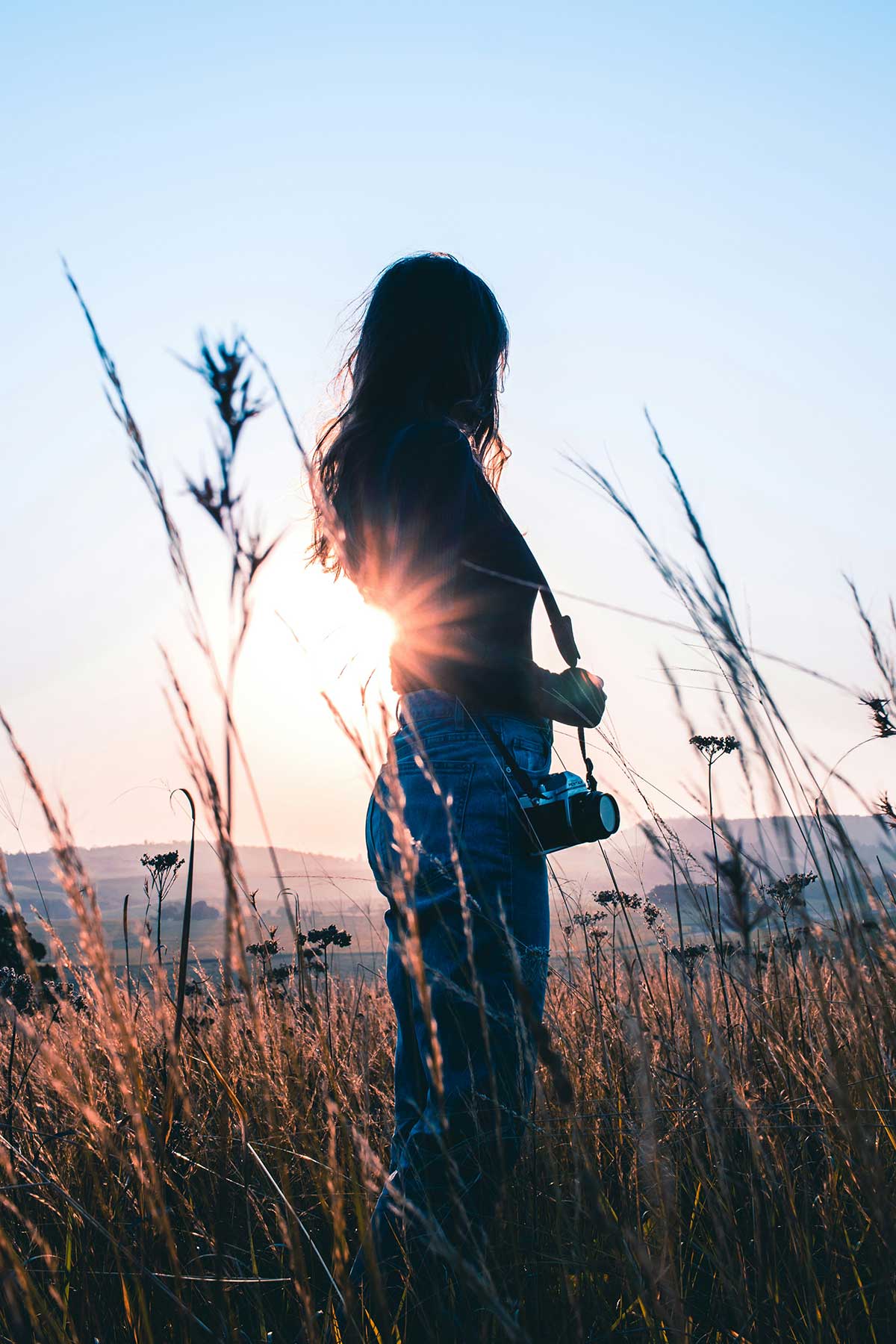
According to the Oxford English Dictionary, the word essence is defined as:
The intrinsic nature or indispensable quality of something that determines its character.
Also: A property or spirit that gives something its identity and meaning.
When everything else is gone, essence is what's left. It is the silent core of who we are, the aspect that isn't performing, comparing, or striving. Essence is what gives our creative endeavors their genuineness. It's the emotion behind the form, the voice beneath the technique.
We cease striving to be something and just are when we paint, write, or construct from essence. Originality occurs here through alignment rather than effort.
Working with essence entails taking your time and paying attention to what is real.
It entails identifying what feels performative and what feels real. It's the change from creating art to impress to creating art that truly captures our inner selves.
What am I attempting to convey underneath the picture, underneath the concept?
Essence resides there.
We start to remove the layers of habit and expectation as we become more self-aware through introspection, psychology, and creative endeavors. Lack is not what we discover underneath. It's quiet brilliance, clarity, and purpose.
It is impossible to create essence. It's important to keep in mind.
Let’s tap into our creative intuition and do some self-reflective work inspired by our theme. Below you will see our month’s Oracle/Tarot card spread. But fear not, if you are not one drawn to using oracle or tarot cards, no worries, just use the accompanying reflective questions as writing prompts for your journals!
Here’s a three-card oracle card spread designed to tap into your creative intuition and our themes. This spread and its journaling prompts encourage reflection on the artist’s inner wisdom, the magic of inspiration, and the journey of trusting intuition in the creative process.
This spread works beautifully with oracle or tarot decks.

Treat yourself to this wonderful and powerful meditation from one of my favorite meditation creators - Rachel Hillary
Here’s a little more information from Rachel…
This meditation journey is a little different from my other creations in that it is more energy-based than usual. This meditation will pluck a specific chord within you, whatever you most need right now. We connect our third eye energy with our heart energy and begin a journey into expansion and unfolding, allowing ourselves to flow beyond the limits we may usually put upon ourselves. Music by Chris Collins, Indie Music Box. Enjoy!
lots of love,
Rachel
Each month we will have a positive affirmation. I recommend you print out this affirmation and put it in your sketchbook or somewhere in your studio. Recite the affirmation out loud each time you show up to create. Saying words aloud is powerful and can begin to re-write some of our own limiting beliefs or calm our fears. Try it now…
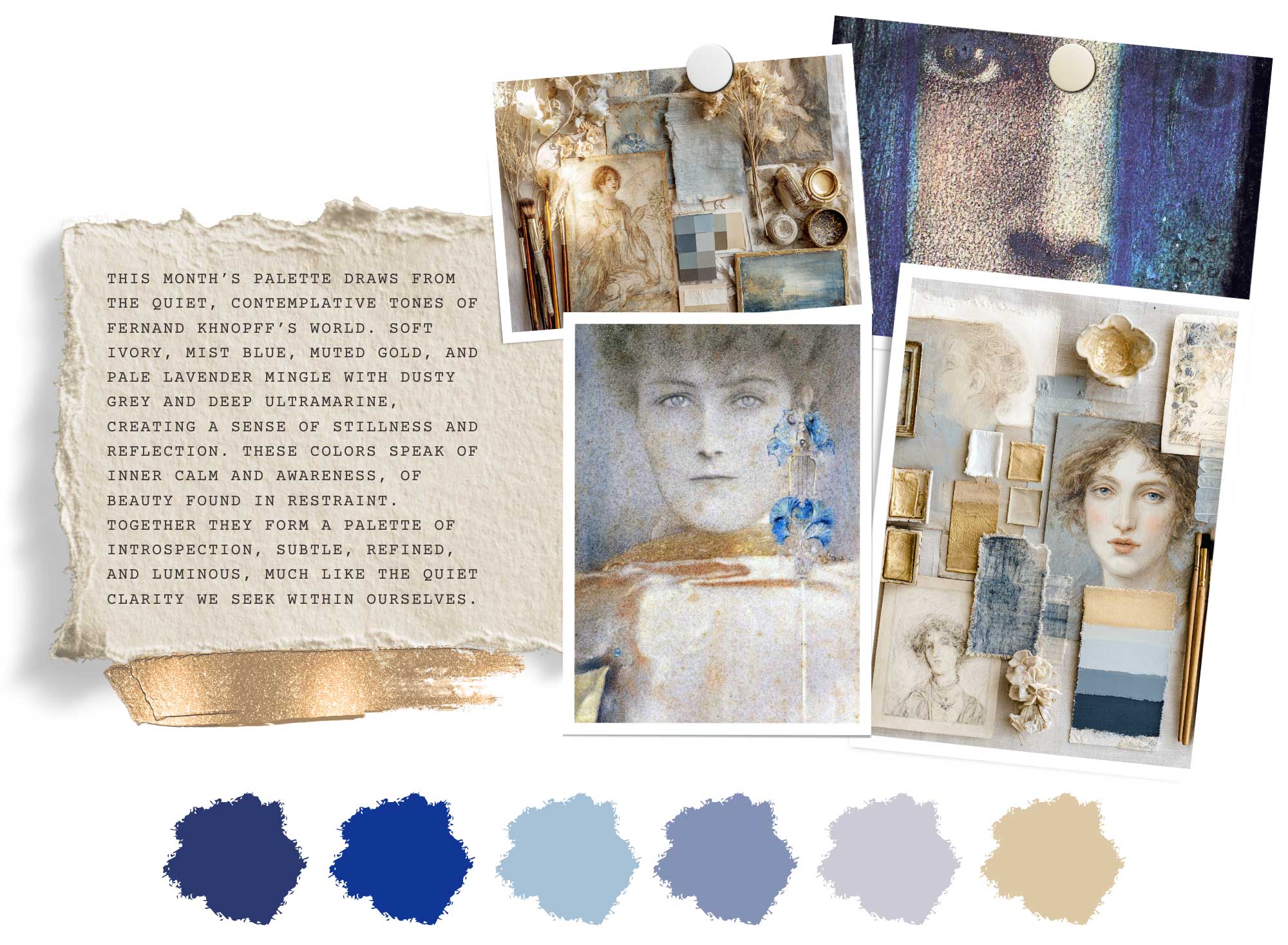
This month’s palette draws inspiration from the hushed interiors and dreamlike portraits of Fernand Khnopff, where silence becomes color and stillness becomes light. His world is one of restraint and reflection, a palette that mirrors thought itself.
We’re working with soft ivory and mist blue, hues that feel like morning light diffused through sheer fabric. Muted gold brings warmth to the coolness, like a quiet pulse beneath composure. Pale lavender and dusty grey carry the calm of introspection, while deep ultramarine anchors everything in depth and mystery.
Together, these tones create a language of subtle contrast, clarity and obscurity, restraint and emotion, stillness and soul. They remind us that quiet can be powerful, and that essence often reveals itself not in brilliance, but in whispers.
As you work with these colors, think of them as meditations rather than choices. Let them breathe, layer, and dissolve. Notice how a wash of grey softens a line of gold, or how a cool blue can hold warmth when paired with ivory.
Let the palette become what Khnopff’s paintings are: a mirror for the inner world, distilled to its most essential truth.

In the stillness of Fernand Khnopff’s paintings, one senses a mind turned inward, a life devoted to the quiet search for essence. His art does not describe the outer world; it distills it. Each face, interior, and symbol seems suspended in thought, held in that liminal space between reality and dream. To encounter Khnopff is to enter a world where art becomes meditation, a mirror for the interior life.
Fernand Edmond Jean Marie Khnopff (1858 - 1921) was born in Grembergen, Belgium, into an aristocratic family. When he was still a child, his family moved to the medieval city of Bruges, a place whose quiet streets and melancholic beauty imprinted deeply on him. Bruges, with its canals and still water, became the archetype of memory and introspection that would echo through his art.
Following family expectations, Khnopff initially studied law in Brussels, but his inner life was already pulling him elsewhere. By 1876, he abandoned law to study at the Académie Royale des Beaux-Arts and later spent time in Paris, where he encountered the mystical allegories of Gustave Moreau and the poetic restraint of the Pre-Raphaelites. Their influence gave him a language for what he already sensed: that the role of the artist was not to depict but to reveal.
In 1883, he became a founding member of Les XX , a collective of Belgian avant-garde artists determined to break from academic convention. Within this circle, Khnopff emerged as a quiet visionary. His precision, psychological nuance, and restraint distinguished him from his more flamboyant contemporaries. By the late 1880s and 1890s, his work was exhibited widely across Europe, and his influence spread beyond Belgium. When he participated in the first Vienna Secession exhibition in 1898, Gustav Klimt himself was said to be inspired by Khnopff’s ethereal stillness and symbolic depth.
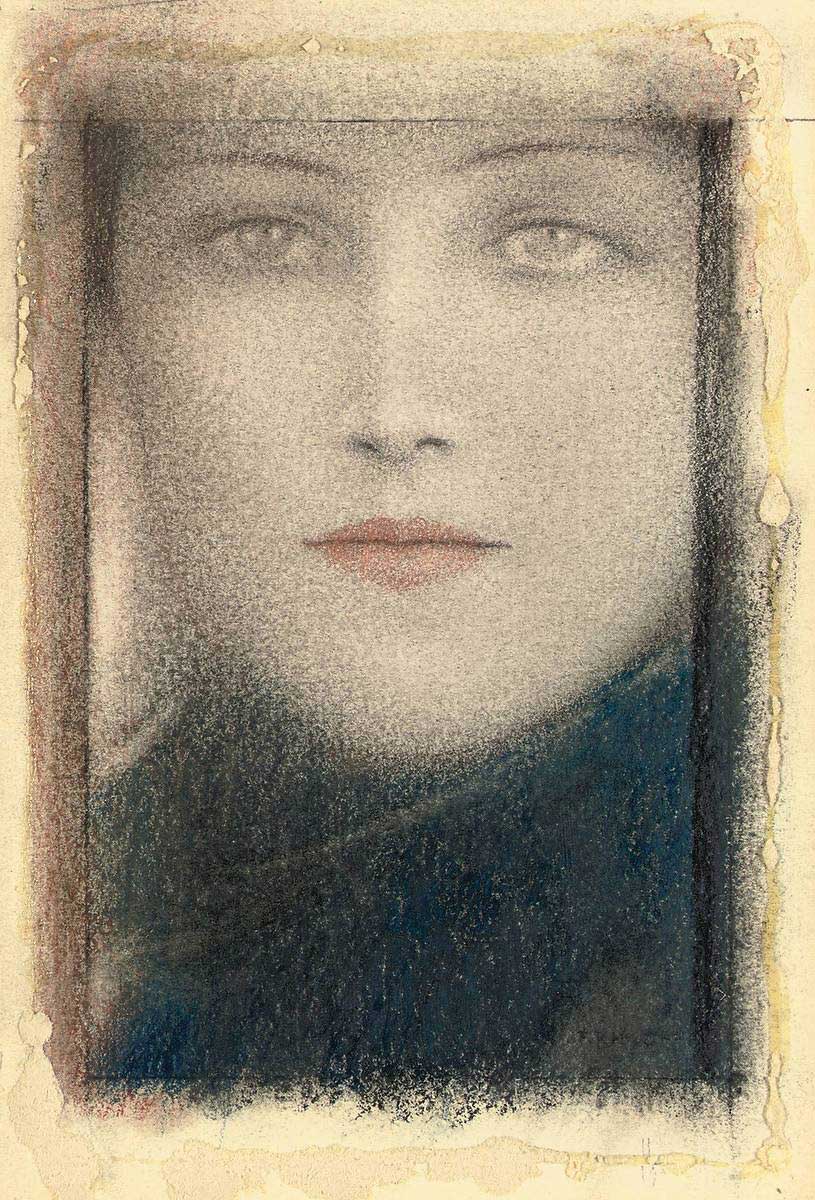
Tête de femme (Head of a woman)
By Fernand Khnopff, 1910
Khnopff’s house and studio in Brussels, completed around 1900, stood as a physical manifestation of his philosophy, a “Temple of the Self.” Above the entrance, he inscribed his personal motto: On n’a que soi, One has only oneself. The building was spare, geometric, and ritualistic. White walls, blue draperies, and controlled light created an environment of introspection and focus. Every object and proportion was chosen with symbolic intent. It was not a home in the domestic sense, but a sanctuary for contemplation, an architectural echo of his paintings’ inner calm.
This idea of art as a sacred space, both literal and psychological, lies at the heart of his creative practice. He once wrote, “I always meditate on my subjects for a long time before attempting to translate them… I want precision.” That precision was not about technical accuracy but about spiritual exactness , the alignment of thought, feeling, and form.
Khnopff’s art occupies the space between beauty and emotion, intellect and spirit. His subjects are often women, pale, distant, representing not personality but archetype. Chief among them was his sister, Marguerite Khnopff, whose face became the embodiment of his muse: serene, self-contained, unknowable. In works such as I Lock My Door Upon Myself (1891) and Silence (c.1890), she becomes less a portrait than a symbol, a visual metaphor for the inward gaze.
In The Caress of the Sphinx (1896), one of his most celebrated works, a mythical creature leans into a young man, their encounter poised between danger and desire. The painting feels psychological rather than mythological,, a dialogue between instinct and intellect, the conscious and unconscious self. Khnopff’s palette reinforces this duality: cool blues and greys balanced with muted gold, light meeting shadow in delicate equilibrium.
His world is one of stillness, silence, and exquisite restraint. Each image suggests that the real drama of art , and of life , unfolds not in action, but in awareness.

I Lock My Door Upon Myself
By Fernand Khnopff, 1891
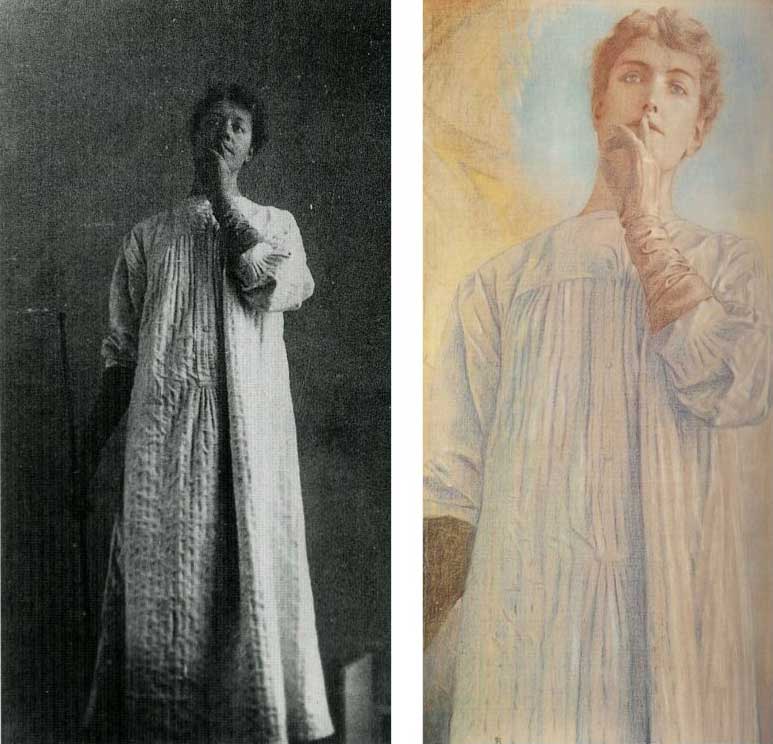
Silence - (His sister Marguerite as model)
By Fernand Khnopff, 1890
Khnopff’s art aligns naturally with this month’s Studioworks theme, Know Thyself: The Artist Within. His paintings are not expressions of personality, but studies in essence. He once described his creative process as a long meditation before making the first mark. That meditative attention, the act of seeing inwardly before expressing outwardly, mirrors what it means to make art from self-awareness.
His figures inhabit sealed rooms, solitary interiors, or undefined dreamscapes, each space a metaphor for the mind. They are archetypal rather than literal: the Muse, the Dreamer, the Silent Self. In his work, the act of turning inward becomes not isolation, but illumination.
Khnopff’s influence rippled through the Vienna Secession and into modern art, shaping the aesthetics of Klimt, Moser, and Schiele. His quiet vision anticipated the 20th century’s fascination with psychology and identity, echoing the emerging ideas of Freud and Jung. He revealed that art could be both disciplined and dreamlike, personal and universal, a bridge between consciousness and mystery.
Though often considered enigmatic, his legacy is deeply human. His stillness was not detachment, but devotion. Through his silence, he invited the viewer to listen inwardly, to encounter the self behind the gaze.

The Caress of the Sphinx
By Fernand Khnopff, 1896
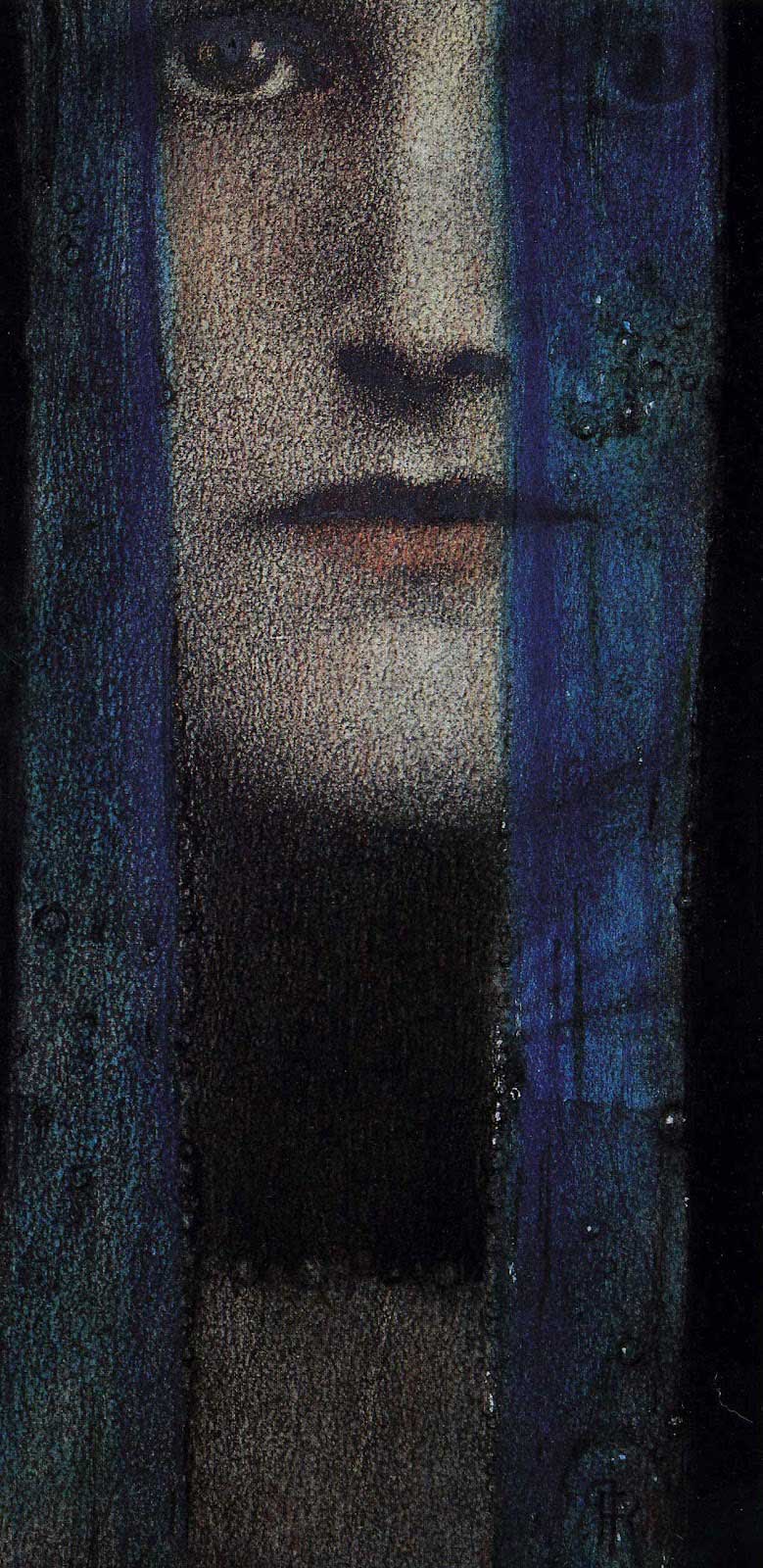
Un Rideau Bleu (A Blue Curtain)
By Fernand Khnopff, 1909
If we were to imagine Khnopff through the lens of the Enneagram, he might align most closely with Type Five, The Observer. The Fives seek knowledge, autonomy, and mastery. They turn inward to understand the world before engaging it. Their strength lies in depth and clarity; their challenge lies in detachment and reserve.
Khnopff’s disciplined introspection, his self-contained studio life, and his fascination with the architecture of silence all speak to the Type Five temperament. Yet there are elements of Type Four, The Individualist in his poetic melancholy and aesthetic refinement. The intersection of those types, the emotional depth of Four and the intellect of Five, might best describe his essence: sensitive, exacting, and ever seeking inner truth through art.
Fernand Khnopff reminds us that art is not only the expression of vision but also the discipline of awareness. His paintings invite us to pause and listen to the quiet spaces within ourselves, to remember that creativity begins in stillness.
In the hush of his colors and the distance of his figures, we recognize what he knew so well: the artist’s truest work is to translate the invisible, to make essence visible.
On a blank page, make a quick, loose self-portrait. It doesn’t have to look like you, think of it as capturing your energy today. You could use a mirror and do a blind contour drawing or use your non-dominant hand. These approaches are low-stakes and produce raw, emotional, abstracted work.
Then, add a soft color wash or collage a few torn papers that feel like your mood.
Reflect: What part of this feels most “you”? Is it the color, the shape, or the feeling it gives?
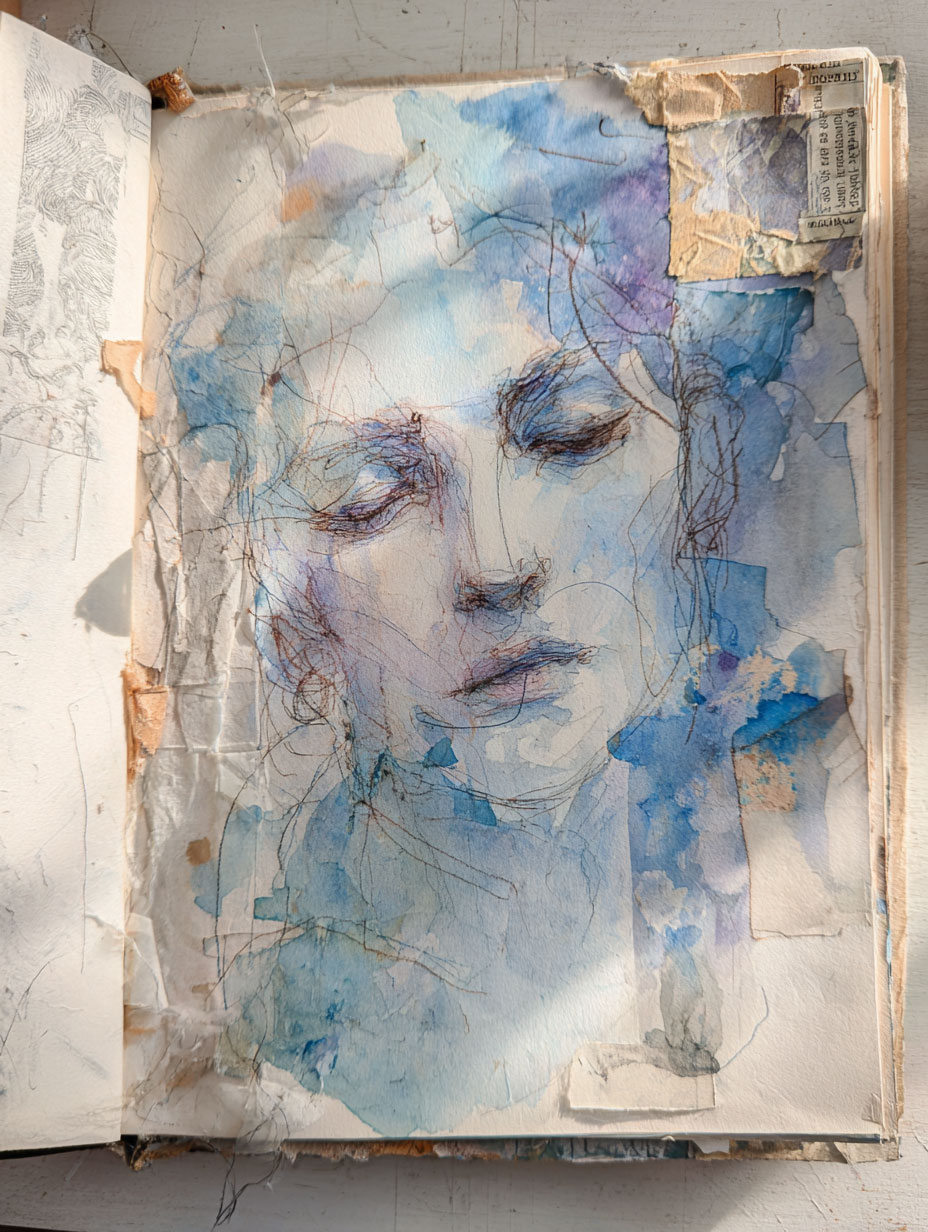

Choose three symbols that feel connected to who you are right now, a key, a bird, a moon, a window, or anything that comes to mind. Draw each one on your page.
Add a little color or texture around them, noticing which feels strongest.
Reflect: Which symbol feels closest to your creative self? What might it be trying to tell you?
Pick one color that matches how you feel, maybe calm blue, grounded brown, or bright yellow. Brush or scribble it across the page.
Now add one or two supporting colors around it. Let them overlap or blend naturally.
Reflect: What story do these colors tell about your state of mind? How does seeing them together make you feel?
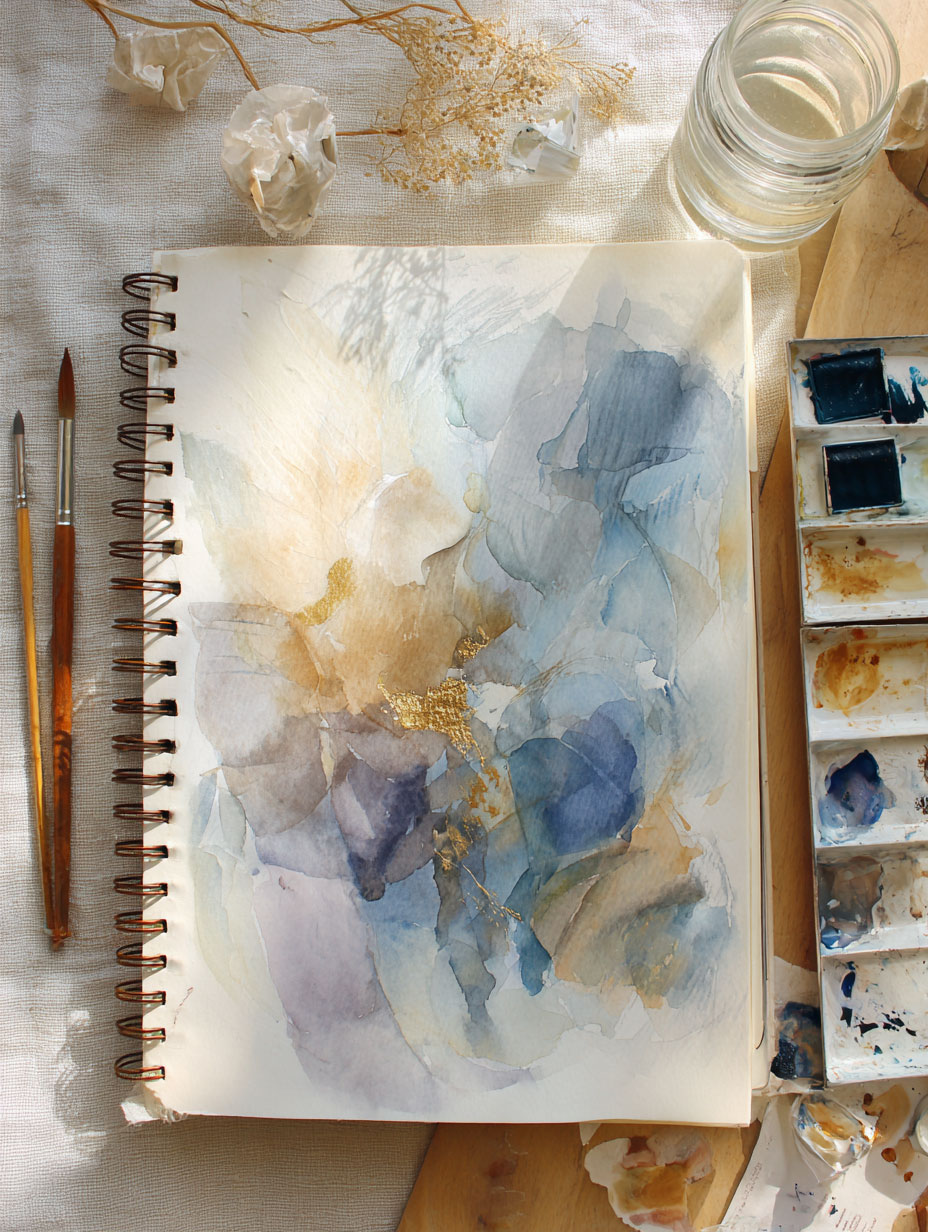
I'm excited to share this mixed media collage with you this month! It's a bit of a self-discovery journey but please feel free to use other images if you don't resonate with doing a self-portrait. The principles and techniques I discuss apply to any method of collage making!
So, grab your favorite old magazines, vintage papers, napkins or other ephemera that you enjoy, your scissors and glue and let's have some fun with this collage project! Allow yourself to really play and explore combining different elements! That's the beauty of collage!
Have fun!
You can also listen to this month’s issue of the Studioworks journal. I find I love listening to books, podcasts and music while I draw, paint or go on a long walk. Enjoy.
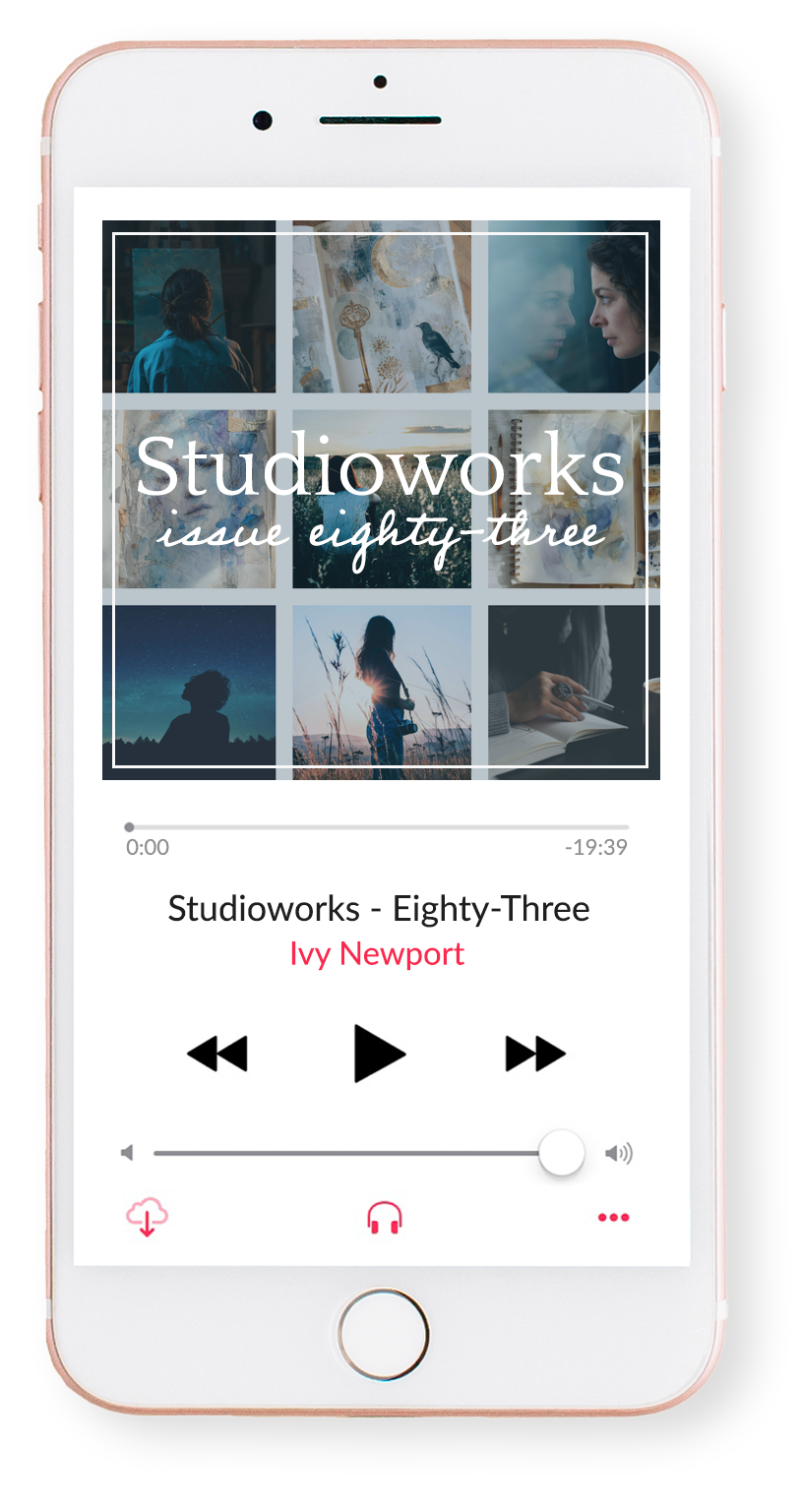
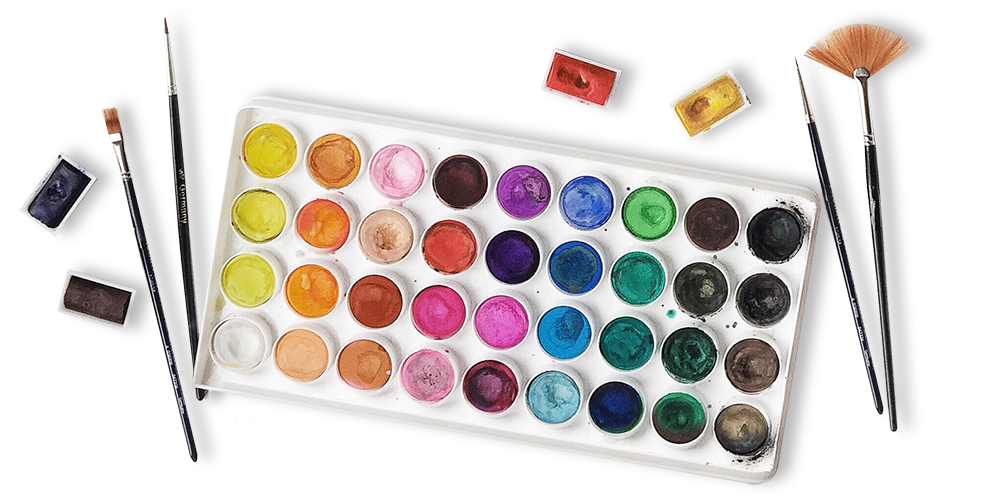
One of my favorite things to do is to curate inspiration. From Pinterest boards to books, resources, playlists and more - I love to share anything that might facilitate learning, expansion, and sparks of curiosity! Being an artist, we naturally crave these things so here are some of this month’s picks from me to you.
I had so much fun curating this list. I hope you enjoy!!
Classes that pair well with this month’s theme in your Studioworks Creative Library